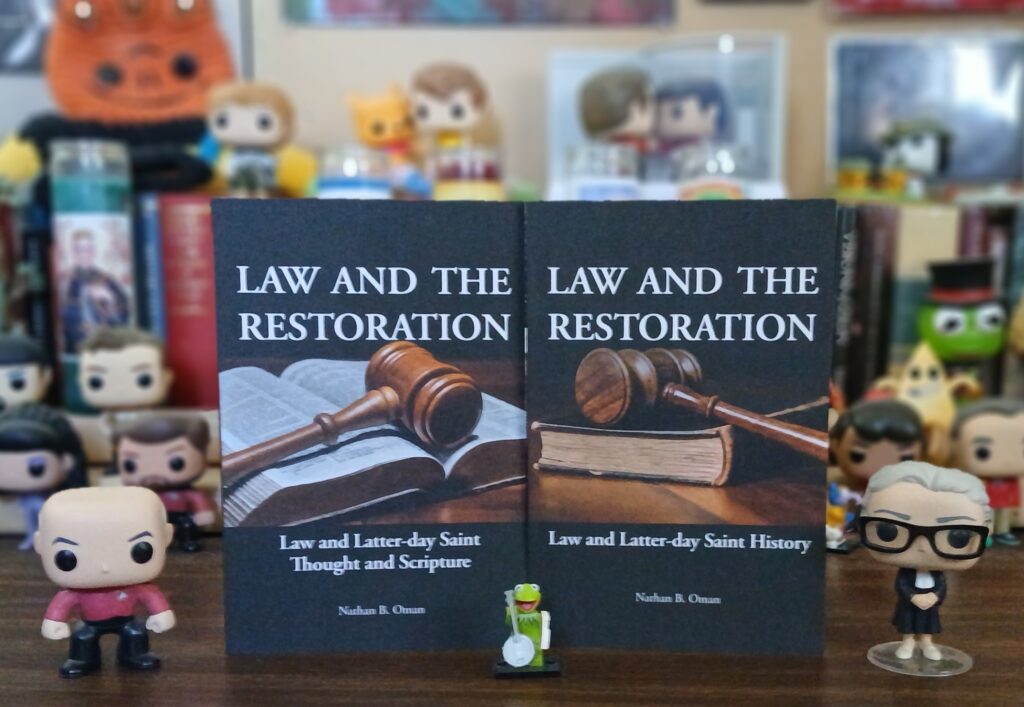Reviews
———-
Title: Law and the Restoration: Law and Latter-day Saint History & Law and the Restoration: Law and Latter-day Saint Thought and Scripture
Author: Nathan B. Oman
Publisher: Greg Kofford Books
Genre: Religious Non-fiction
Year Published: 2024
Number of Pages: 368 pages, 249 pages
Format: Paperback
ISBN: 978-1-58958-796-0, 978-1-58958-808-0
Price: $34.95, $27.95
Reviewed by Conor Hilton for the Association of Mormon Letters
Nathan B. Oman’s two-volume Law and the Restoration series at Greg Kofford Books is a thoughtful, careful, often provocative approach to reading and interpreting Latter-day Saint history, thought, practice, and scripture. Oman’s core goal is essentially “to model ways in which disciplined reflection on the relationship between law and Mormonism might be conducted given the eclecticism of legal thought” (xi). The first volume, Law and Latter-day Saint History suggests that work in this area should “Focus on what the Latter-day Saint legal experience tells us about legal history, the relationship between law and religion, or the role of law in the rise of a new religious tradition” (xiii). The second volume, Law and Latter-day Saint Thought and Scripture models the ways that ideas from legal thought can be applied to Mormonism, as well as the ways that Mormon practices and scripture can be fruitfully read through a legal lens.
Together, the two volumes emphatically demonstrate the value of these goals and approaches. Many of the essays contained in both have been published elsewhere in a variety of locations—Mormon studies journals, newsletters, and academic legal journals. They are gathered together in print for the first time here, along with some never-before-published material. Oman’s thinking is rich and rewards careful engagement. I hope many begin the process of digging into his thoughts and developing their own applications of the approaches that he models here.
Law and the Restoration: Law and Latter-day Saint History is a valuable contribution to examining the intersections of law and Mormonism. Oman skillfully demonstrates the myriad ways that the law has shaped LDS teachings and practices and therefore, the value of thoughtfully examining the nature of that intersection. Perhaps one of the greatest innovations from this volume is chapter eight, which explores the development of LDS marital sealing rules. In this chapter, Oman treats LDS practice as a sort of Mormon “common law,” looking at all of the different rules that have governed the practice and seeking to discern what ties them together and what might be understood by looking at them all alongside each other, as a continuous set of ‘rulings’ or somewhat competing “precedents.” Oman’s work in this chapter appears to be the backdrop for two of his most provocative chapters in the second volume, both dealing with same-sex relationships. Here, the focus is more descriptive, to lay out the different ways the practice has been implemented to demonstrate how the changes in the practice may influence teachings (and vice versa). Other chapters in the book offer different examples, highlighting different elements of the law—the chapters about polygamy and the legal organization of the church are both quite insightful on various subjects of American legal/political history, as well as for shining light on how legal realities result in changes in LDS teachings and practices. Perhaps the most fascinating example of this, in my eyes, is found in the final chapter, which details how LDS theology of the state has shifted and used different emphases related to the international legal realities of the church and its members.
Law and the Restoration: Law and Latter-day Saint Thought and Scripture, while slimmer in pages, holds more distinct essays and, for my interests, even more value than the first volume. Throughout the book, Oman demonstrates careful, close reading and thoughtful, measured, charitable thinking. I didn’t always agree with him, but I found the opportunity to think alongside him incredibly rewarding. Every essay here is a standout, with chapters two (on church doctrine), seven (on same-sex marriage), eight (on same-sex sealings), and twelve (on war and atonement in the Book of Mormon) being the four that I’ll be thinking about and talking about with others for quite some time. Oman’s take on church doctrine would be particularly valuable to countless discussions of Mormonism, as he tackles one of the persistent issues and points of tension in online (and in-person) Mormon discourse—what is church doctrine? And how do we relate to it? Oman follows different models of law to explore these questions, settling on a ‘law as integrity’ model. Occasionally, I found myself wishing these essays were a tad longer, offering a bit more context or space to explore more thoroughly the implications of Oman’s ideas. But if, after more than 600 total pages of writing on the law and the restoration, I still wanted more, that strikes me as perhaps the strongest endorsement I can make.
I could cite countless observations, interpretations, and other fascinating or provocative tidbits from these books. They are chockful of them, as befits the clear, careful, precise thinking that they demonstrate. I hope that many more disciples, scholars, and disciple-scholars find their way to these two volumes of Nathan B. Oman’s Law and the Restoration. May more of us apply the type of thinking and reading that Oman models here—our thought and scholarship, and possibly even our discipleship, will be the richer for it.

